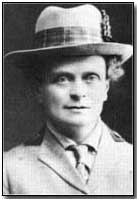Who's Who - Elsie Inglis
 Elsie Maud Inglis (1864-1917),
the British suffragette and pioneer of medicine, established a
hospital fully staffed by women for use by the French government during the
First World War (the British government having earlier turned down an offer
of her services).
Elsie Maud Inglis (1864-1917),
the British suffragette and pioneer of medicine, established a
hospital fully staffed by women for use by the French government during the
First World War (the British government having earlier turned down an offer
of her services).
Born in India in 1864 Inglis and her family returned to their former homeland of Scotland upon the retirement of her father when she was 14, the family choosing to settle in Edinburgh.
Having studied medicine at the Edinburgh School of Medicine for Women Inglis subsequently established her own medical college (with the moral and financial backing of her father). She qualified as a doctor and secured a teaching appointment at the New Hospital for Women under the latter's founder, Elizabeth Garrett Anderson. A keen suffragette Inglis was later to found her own maternity hospital entirely staffed by women.
In 1906 Inglis played a notable role in the establishment of the Scottish Women's Suffrage Federation. The outbreak of war in Europe in August 1914 brought about a temporary ceasefire where political - including suffragette - issues were concerned, and Inglis promptly suggested the creation of women's medical units on the Western Front.
The British government reacted to Inglis's idea coolly however. Nevertheless a similar offer made directly to the French government was warmly received and Inglis travelled to France within three months of the outbreak of war, with the Abbaye de Royaumont hospital, containing some 200 beds, in place by December 1914. This was later followed by a second hospital at Villers Cotterets in 1917.
Inglis was active in arranging for the despatch of women's units to other fighting areas aside from the Western Front: to Serbia, Salonika, Romania, Malta and Corsica in 1915 and to Russia the following year.
Inglis herself served in Serbia from 1915 until the Serbian government and army withdrew to Corfu (Inglis earlier been captured for a period until U.S. diplomatic pressure brought about her release). Thereafter based in Russia she was taken ill and returned to England where she died on 26 November 1917 a day after her arrival in Newcastle Upon Tyne.
A Greyback was a British Army shirt.
- Did you know?
